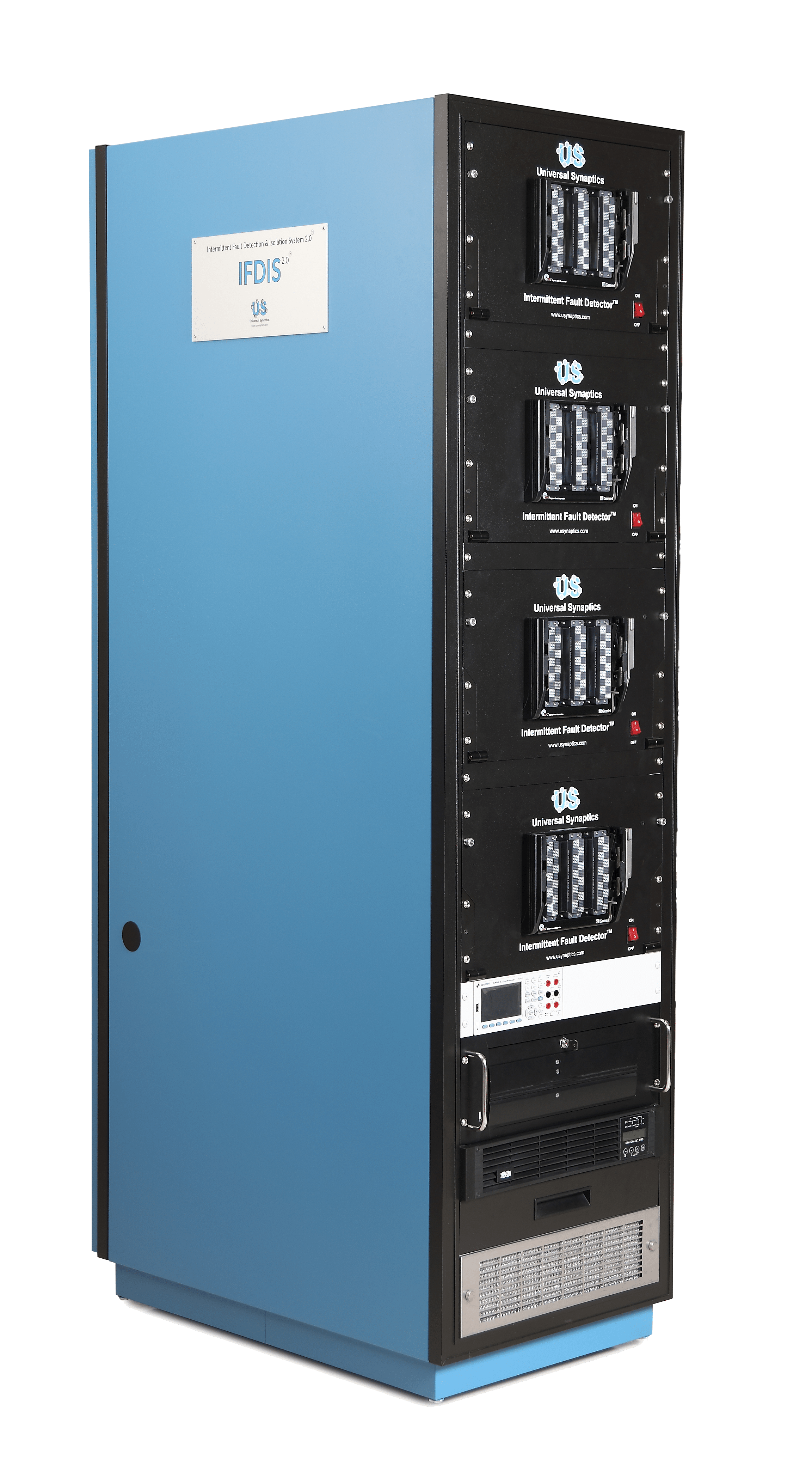Intermittent Fault Detection & Isolation System™ (IFDIS™)
Technology Demonstration Project
Performed for: CUSTOMER INFORMATION REMOVED
Unit Under Test: Elevator and Aileron Computer (ELAC)
Part Number: 3945122505
Introduction
Intermittent / No Fault Found (NFF) issues in complex electronic boxes cost industry and the US Government billions of dollars per year. For example, the associated annual cost to the Department of Defense (DoD) is in excess of $2 billion annually. This has been a long standing problem because legacy testers were not designed to, and are incapable of, detecting and isolating intermittent faults. Therefore, these faults remain undetected for years and even decades, causing the boxes to continually cycle through the depot, never actually being repaired and driving up maintenance costs.
Revolutionary technology has been designed, developed and is now consistently delivering, a unique capability that specifically detects and isolates intermittent faults in electronic systems, enabling them to finally be repaired. The testing employing this technology is known as the Intermittent Fault Detection & Isolation System™ (IFDIS™). The F-16 AN/APG-68 Radar System Modular Low Power Radio Frequency Unit (MLPRF), a high Intermittent / NFF Line Replaceable Unit (LRU), was successfully tested with the IFDIS. Over 60% of the 400 units tested were found to have one or more intermittent faults that went undetected with conventional test equipment. Once detected and isolated, these faults were repaired and the reliability of the MLPRFs was increased by over 300%.

IFDIS Demonstration Test Item – Elevator and Aileron Computer (ELAC)
The Elevator and Aileron Computer (ELAC) is a top Replaceable Assembly degrader for Customer Information Removed because of suspected Intermittent / NFF issues. The purpose of this Technology Demonstration Project (TDP) is to determine if the IFDIS can detect the intermittent faults present in ELACs that none of the test equipment currently available to Customer Information Removed is capable of detecting. Detecting, isolating and repairing the intermittent faults in the ELACs will substantially reduce the NFF rate and increase the ELAC availability, as has been the case with the F-16 MLPRF and several other IFDIS projects.
To support an IFDIS Technology Demonstration Project for the ELAC, Customer Information Removed management agreed to provide five ELACs to Universal Synaptics for IFDIS testing and intermittent fault repair. The effort included designing and building an Interface Test Adapter (ITA) to electrically connect the ELAC to the IFDIS. IFDIS Test Manager Software was created for the ELAC which includes new graphics for diagnosis; an example is illustrated in the next section titled IFDIS System Overview. The ELACs were then IFDIS tested and intermittent faults were detected in all five (100%), of the ELACs. The serial numbers (S/Ns) on the IFDIS tested ELACs are 6331, 6214, 5983, 2070 and 6553. The test results for each of these units are provided in this report.
IFDIS System Overview
Four major components comprise the IFDIS. The first is the Intermittent Fault Detector (IFD) which is a neural network analog diagnostic instrument that simultaneously and continuously monitors all the circuit paths in avionics or other electronics chassis. It detects and records even momentary discontinuities as short as 50 nanoseconds. The second component is a shake table and the third is an environmental chamber. These are used to simulate the flight environment, because the intermittent faults often only occur in that environment. The fourth element is the ITA that interconnects a Unit Under Test (UUT) to the IFD.
Once a fault is detected in a UUT by the IFDIS, the test data is recorded and the precise faulty circuit is reported to the test technician by means of a displayed graphic. An example of a representative graphic is presented next. The colored circles on the graphic represent the connection points within the ELAC chassis. The black line indicates the circuit and connection points of a detected intermittent circuit. In this example, the intermittent circuit is tied to three points, J2B-D, CANP1-C9 and CANP1-B9.
Following the Fault Detection Map Graphic, several photographs are provided to illustrate the IFDIS test setup for the ELAC. The test setup photos include a view of the entire IFDIS test setup as well as closer photos showing more detail.
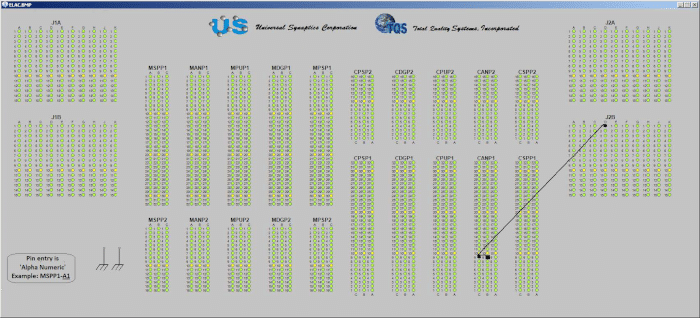
IFDIS – ELAC Fault Isolation Graphic Intermittent Circuit (Note: J1A=D, J1B=E, J2A=A and J2B=B)

ELAC on Vibration Table inside the Environmental Chamber Connected to IFDIS via ELAC Interface Test Adapter
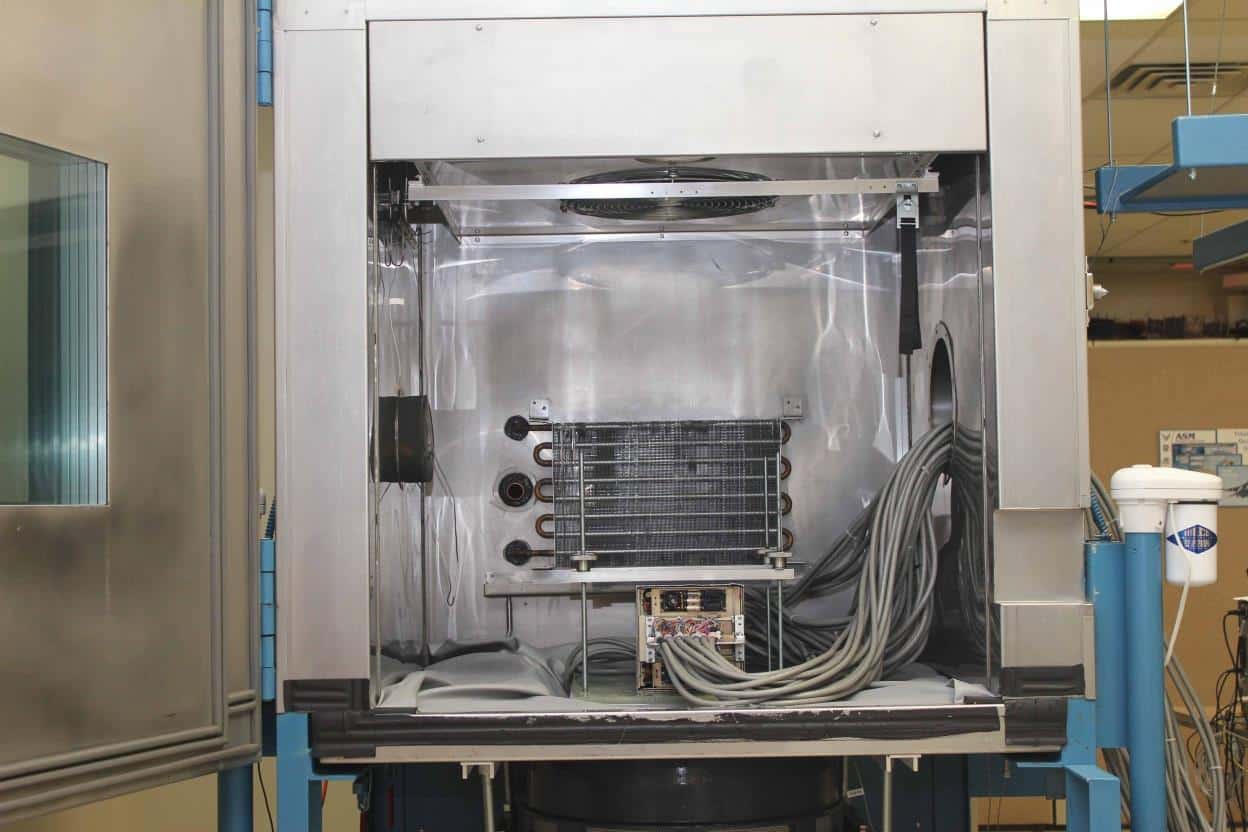
ELAC Mounted for Testing in the IFDIS Environmental Chamber

ELAC (rear view) connected to IFDIS via ELAC Interface Test Adapter
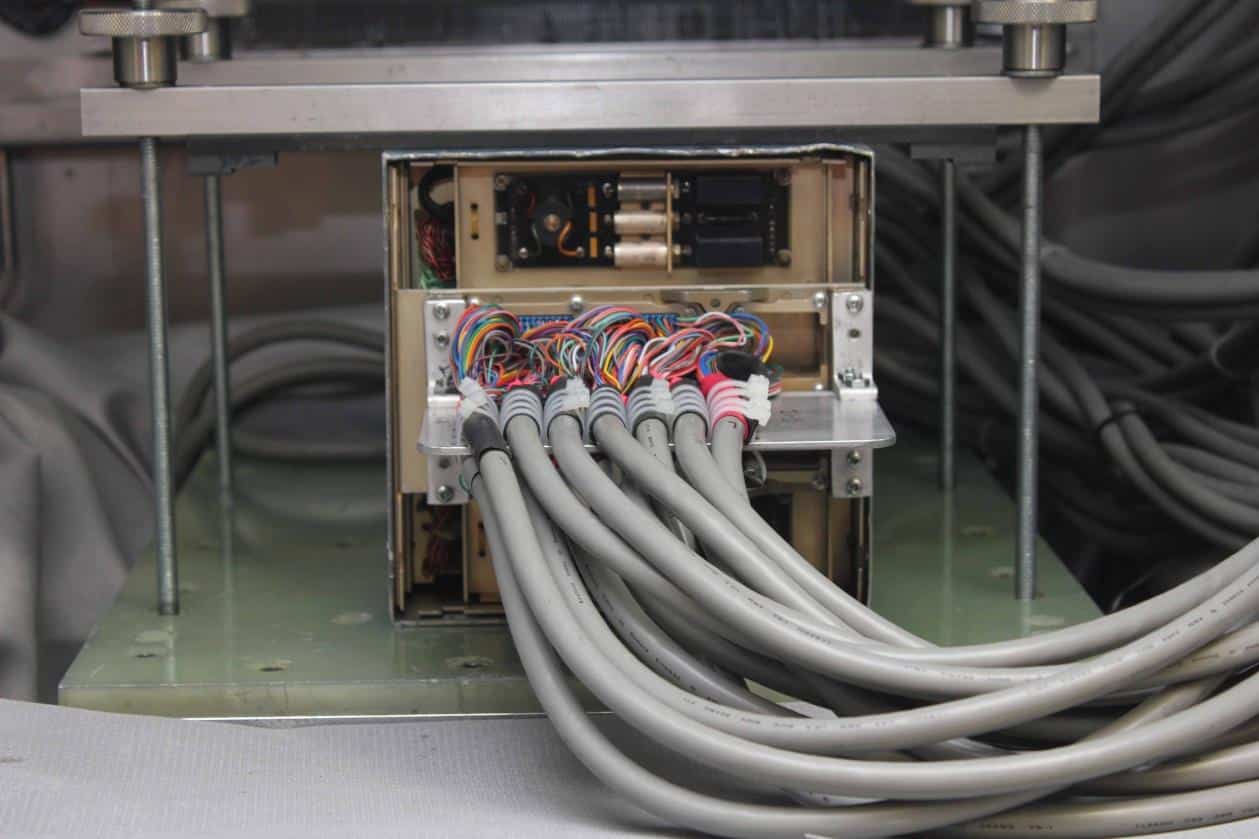
ELAC (front view) on the Vibration Table with Tie Down Bars and Connected to IFDIS via ELAC ITA
A typical IFDIS testing profile is summarized in the following table. This is the profile that was used to test the ELAC.
| Test Phase | Name | Temperature (Degrees Celsius) | Vibration Profile | Comments |
| I | Continuity | Ambient (approx. 21 degrees C) | None | Tests all chassis circuits for proper continuity |
| II | Shorts | Ambient | None | Tests all chassis circuits for any improper short circuits |
| III | Vibration – Ambient | Ambient | Acceptance, Sine Sweep, Random, “Fast” Sine | Four vibration profiles are run at ambient temperature conditions |
| IV | Vibration – Cold Soak | -15 | Acceptance, Sine Sweep, Random, “Fast” Sine | 15 min cold soak at 0, then full vibration test; repeat at -15 degrees |
| V | Vibration – Heat Soak | 70 | Acceptance, Sine Sweep, Random, “Fast” Sine | 15 min heat soak at 70, then full vibration test |
| VI | Cool Down to Ambient & Disconnect | Ambient | None |
Test Results
ELAC Unit S/N 6214
| Test Phase | Name | Temperature (Degrees Celsius) | Comments |
| I | Continuity | Ambient (approx. 21 degrees C) | Passed IFDIS Continuity Test |
| II | Shorts | Ambient | Passed IFDIS Shorts Test |
| III | Vibration – Ambient | Ambient | Passed all IFDIS ambient temperature vibration tests. |
| IV | Vibration – Cold Soak | -15 |
|
| V | Vibration – Heat Soak | 70 |
|
| VI | Cool Down to Ambient & Disconnect | Ambient | After cool down, the identified circuits were inspected and each wire end was soldered to repair the connection. |
After the initial testing and repairs to the circuits were completed, the unit was retested fully and it then passed all tests.
Some representative test result displays are presented and discussed to provide more insight into the IFDIS detection and isolation process. Not all circuits are discussed, but the ones that follow are considered representative and typical of the faults that were found during IFDIS testing.
For Faults IV 1st and 2nd bullets from the preceding test results table, the IFDIS Intermittent Fault Detector (IFD) test result screen display is shown in the figure that follows. It indicates that the system detected chassis intermittent faults in the circuits that terminate at J2A-G14 and at J2A-F14.
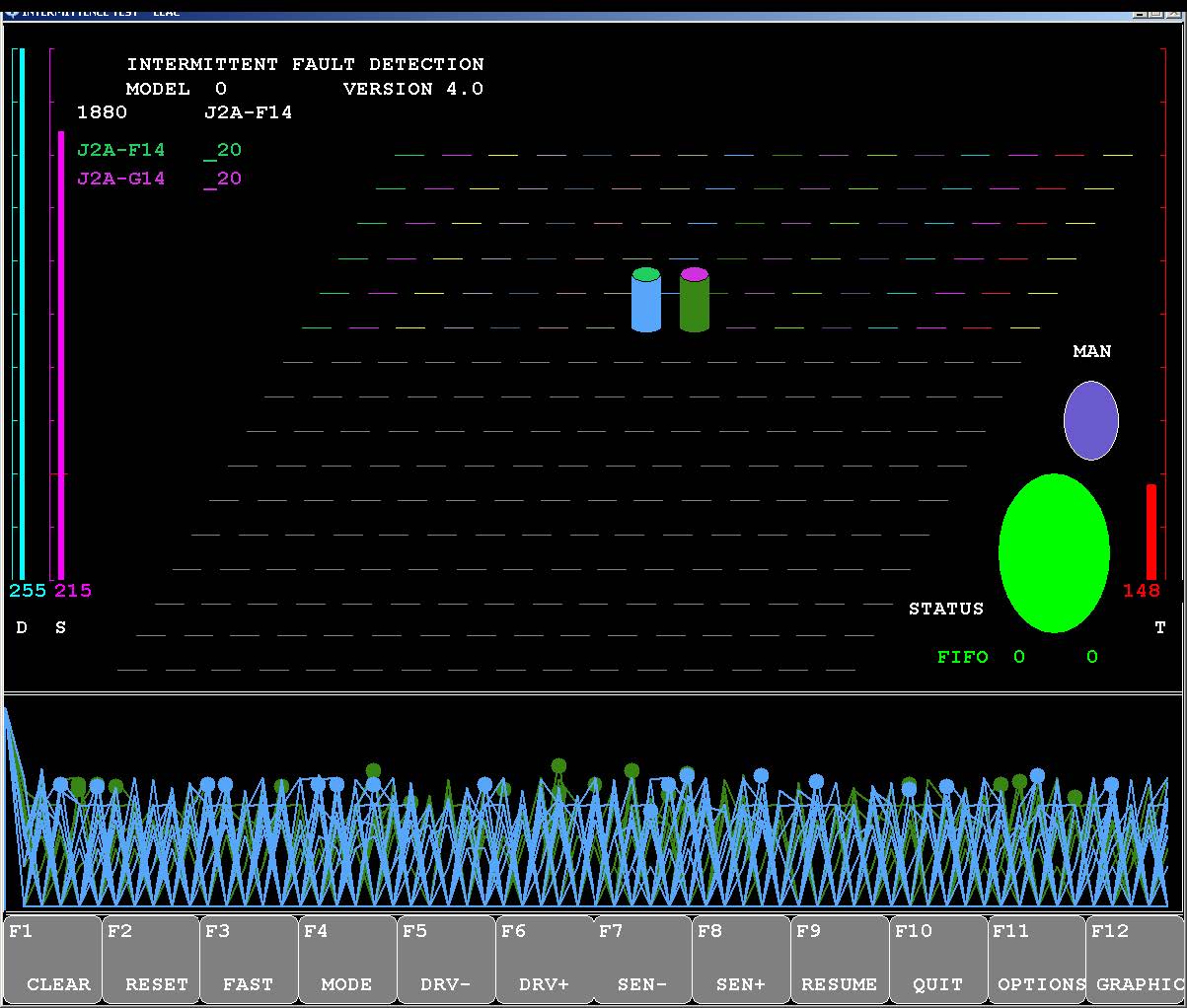
IFDIS test results example – IFD screen shot of J2A-G14 and J2A-G14 intermittent fault capture for ELAC S/N 6214
Corrective Actions: For each intermittent circuit identified, the associated connecting wire end was soldered to its respective terminating post. The ELAC chassis was then retested to verify the circuits were no longer intermittent. The next three photographs show where the wire wrap repairs were made. The locations where the wire wraps were soldered are indicated by the call out boxes and fault circuit designators. The matched colored boxes indicate the locations of both ends of each intermittent circuit that were detected.
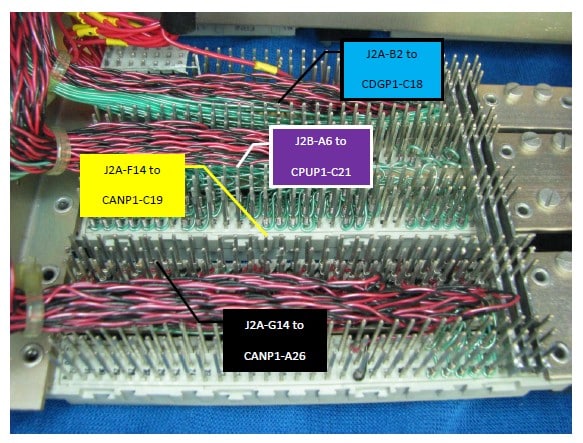
ELAC wire wrap connections for the CSP, CAN, CPU, CDG, and CPS cards (Call out boxes indicate wire wrap solder repair locations for ELAC S/N 6214)

ELAC wire wrap connections for the MSP, MAN, MPU, MDG, and MPS cards (Call out box indicates wire wrap solder repair location for ELAC S/N 6214)
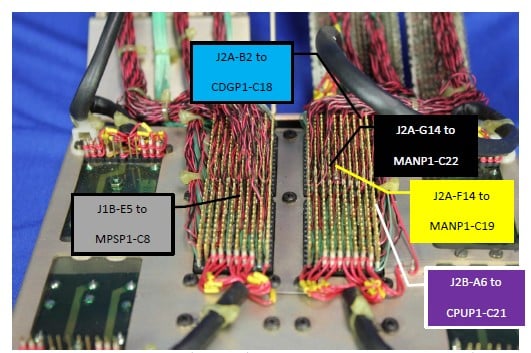
ELAC wire wrap connections for the J1A, J1B, J2A, and J2B connectors (Call out boxes indicates wire wrap solder repair locations for ELAC S/N 6214)
ELAC Unit S/N 5983
| Test Phase | Name | Temperature (Degrees Celsius) | Comments |
| I | Continuity | Ambient (approx. 21 degrees C) |
|
| II | Shorts | Ambient | Passed IFDIS Shorts Test |
| III | Vibration – Ambient | Ambient | Passed all IFDIS ambient temperature vibration tests |
| IV | Vibration – Cold Soak | -15 | Passed all IFDIS cold soak temperature vibration tests |
| V | Vibration – Heat Soak | 70 |
|
| VI | Cool Down to Ambient & Disconnect | Ambient | After cool down, the identified circuits were inspected and each wire end was soldered to repair the connection |
After the initial testing and repairs to the circuits were completed, the unit was fully retested and it subsequently passed all tests.
Some representative test result displays are presented and discussed to provide more insight into the IFDIS detection and isolation process. Not all circuits are discussed, but the ones that follow are considered representative and typical of the faults that were found using IFDIS testing.
For Test Phase I 1st bullet from the preceding test results table, the IFDIS Intermittent Fault Detector (IFD) test result screen display is presented in the figure that follows. It indicates that the circuit, terminated at J2B-B15, which IFDIS initially detected as open, showed as intermittent during subsequent vibration testing.

IFDIS test results example – IFD screen shot of J2B-B15, which initially showed as an open circuit, but later during vibration, showed as intermittent, for ELAC S/N 5983
Corrective Actions: For each failed circuit identified, the associated connecting wire end was soldered to its respective terminating post. The ELAC chassis was then retested to verify proper connectivity. The next two photographs show where the wire wrap repairs were made. The locations where the wire wraps were soldered are indicated by the call out boxes and fault circuit designators. There matched colored boxes indicate the locations of both ends of each intermittent circuit that were detected.
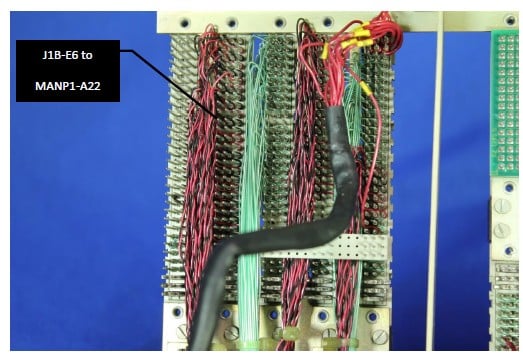
ELAC wire wrap connections for the MSP, MAN, MPU, MDG, and MPS cards (Call out box indicates wire wrap solder repair location for ELAC S/N 5983)
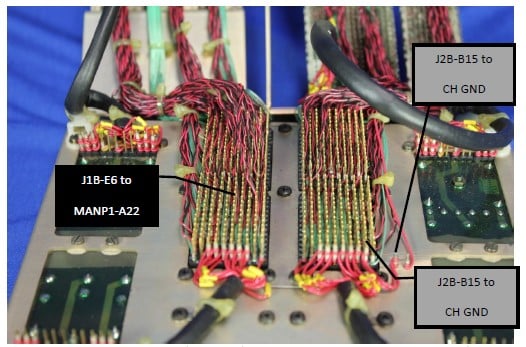
ELAC wire wrap connections for the J1A, J1B, J2A, and J2B connectors (Call out boxes indicate wire wrap solder repair locations for ELAC S/N 5983)
ELAC Unit S/N 6331
| Test Phase | Name | Temperature (Degrees Celsius) | Comments |
| I | Continuity | Ambient (approx. 21 degrees C) | Passed IFDIS Continuity Test |
| II | Shorts | Ambient | Passed IFDIS Shorts Test |
| III | Vibration – Ambient | Ambient | Passed all IFDIS ambient temperature vibration tests |
| IV | Vibration – Cold Soak | -15 |
|
| V | Vibration – Heat Soak | 70 |
|
| VI | Cool Down to Ambient & Disconnect | Ambient | After cool down, the identified circuits were inspected and each wire end was soldered to repair the connection |
After the initial testing and repairs to the circuits were completed, the unit was retested fully and it then passed all tests.
Corrective Actions: For each intermittent circuit identified, the associated connecting wire end was soldered to its respective terminating post. The ELAC chassis was then retested to verify the circuits were no longer intermittent. The next two photographs show where the wire wrap repairs were made. The locations where the wire wraps were soldered are indicated by the call out boxes and fault circuit designators. The matched colored boxes indicate the locations of both ends of each intermittent circuit that was detected.

ELAC wire wrap connections for the MSP, MAN, MPU, MDG, and MPS cards (Call out boxes indicate wire wrap solder repair locations for ELAC S/N 6331)

ELAC wire wrap connections for the J1A, J1B, J2A, and J2B connectors (Call out boxes indicate wire wrap solder repair locations for ELAC S/N 6331)
ELAC Unit S/N 6553
For this ELAC chassis, the intermittent faults detected were numerous and inconsistent among repeated IFDIS testing runs. Upon examination, it was discovered that the CPSP1 connector was broken and hence not seating properly when the ITA was installed. Since replacing a single broken connector is difficult and time consuming, an alternate repair technique was selected. A serviceable electronics assembly from Customer Information Removed was received as a source of parts to repair the ELAC chassis. Examination revealed that this electronics assembly appeared to be in good condition, so the faulty electronic assembly with the broken connector in its entirety was replaced with the Customer Information Removed supplied assembly. After carrying out the replacement of the assembly, ELAC S/N 6553 passed all IFDIS tests as indicated in the below test result table.
| Test Phase | Name | Temperature (Degrees Celsius) | Comments |
| I | Continuity | Ambient (approx. 21 degrees C) | Passed IFDIS Continuity Test |
| II | Shorts | Ambient | Passed IFDIS Shorts Test |
| III | Vibration – Ambient | Ambient | Passed all IFDIS ambient temperature vibration tests |
| IV | Vibration – Cold Soak | -15 | Passed all IFDIS cold soak temperature vibration tests. |
| V | Vibration – Heat Soak | 70 | Passed all IFDIS heat soak temperature vibration tests. |
| VI | Cool Down to Ambient & Disconnect | Ambient |
This resolved all the problems in the ELAC S/N 6553 chassis and revealed that the electronics assembly provided by Customer Information Removed as a source of parts was in fact a good assembly. The electronics assembly with the broken connector removed from ELAC S/N 6553 was removed from ELAC S/N 6553 as was utilized as the source for needed parts.
ELAC Unit S/N 2070
| Test Phase | Name | Temperature (Degrees Celsius) | Comments |
| I | Continuity | Ambient (approx. 21 degrees C) | Passed IFDIS Continuity Test |
| II | Shorts | Ambient |
|
| III | Vibration – Ambient | Ambient | Passed all IFDIS ambient temperature vibration tests |
| IV | Vibration – Cold Soak | -15 | Passed all IFDIS cold soak temperature vibration tests. |
| V | Vibration – Heat Soak | 70 |
|
| VI | Cool Down to Ambient & Disconnect | Ambient | After cool down, the identified circuits were inspected and each wire end was soldered to repair the intermittent connections. The short circuit was corrected by repairing and then repositioning a sheath covered wire bundle so that it would no longer be penetrated by a wire wrap pin. |
After the testing and repairs to the circuits were completed, the unit was retested fully and it then passed all tests.
It should be noted that a circuit was found to be shorted. The problem was diagnosed and it was found that one of the wire wrap pins had penetrated a wire bundle sheath and contacted a grounded wire braid within. As the pin made contact with the braid inside the sheath, the circuit tied to that pin was shorted to ground.
Corrective Actions: For each intermittent circuit identified, the associated connecting wire end was soldered to its respective terminating post. The next three photographs show where the wire wrap repairs were made. The locations where the wire wraps were soldered are indicated by the call out boxes and fault circuit designators. The matched colored boxes indicate the locations of both ends of each intermittent circuit that was detected.
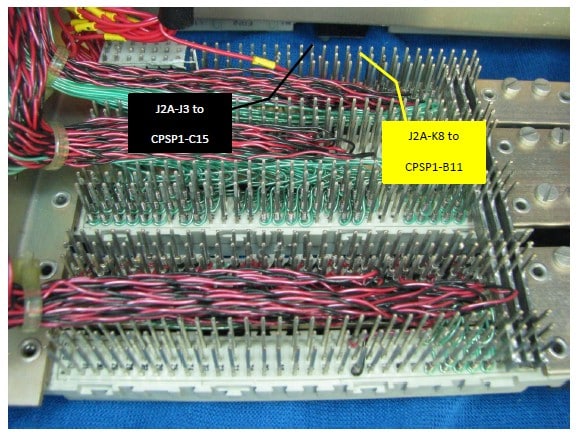
ELAC wire wrap connections for the CSP, CAN, CPU, CDG, and CPS cards (Call out boxes indicate wire wrap solder repair locations for ELAC S/N 2070)

ELAC wire wrap connections for the MSP, MAN, MPU, MDG, and MPS cards (Call out box indicates wire wrap solder repair location for ELAC S/N 2070)

ELAC wire wrap connections for the J1A, J1B, J2A, and J2B connectors (Call out boxes indicate wire wrap solder repair locations for ELAC S/N 2070)
The next photographs illustrate the ELAC chassis short circuit. As highlighted earlier, it was found that a wire wrap pin had penetrated the wire bundle sheath and was pressing against a grounded braid within the sheath. This shorted to ground the circuit tied to that pin. The bundled wires were inspected to determine if the penetrating pin had damaged any wires within the bundle, but none were damaged. The sheath on the bundled wires was repaired. A new and better wire bundle tie down was installed, obtained from the electronic assembly which was cannibalized for parts. This new tie down routes the wire bundle around the wire wrap pins. Because the wire wrap on the penetrating pin was somewhat unwrapped, that pin was also soldered.
After all chassis repairs had been accomplished, the ELAC chassis was again IFDIS tested and passed all tests.
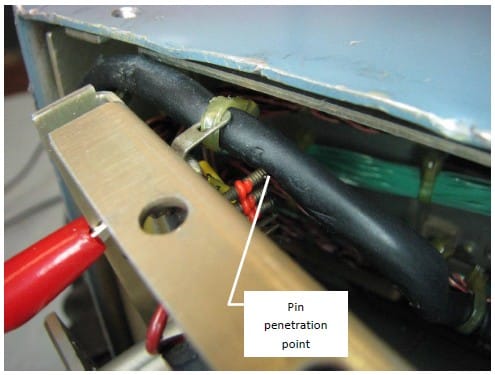
Wire wrap pin penetrating a wire bundle sheath, shorting that circuit to the grounded braid inside – ELAC S/N 2070
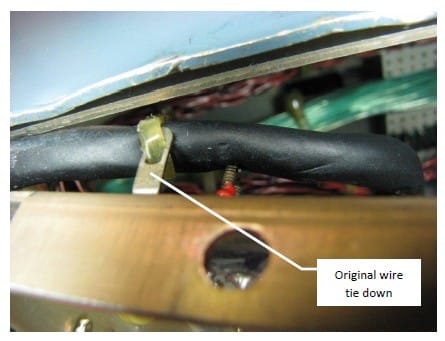
Wire bundle tie down near wire wrap pin penetrating a wire bundle sheath – ELAC S/N 2070
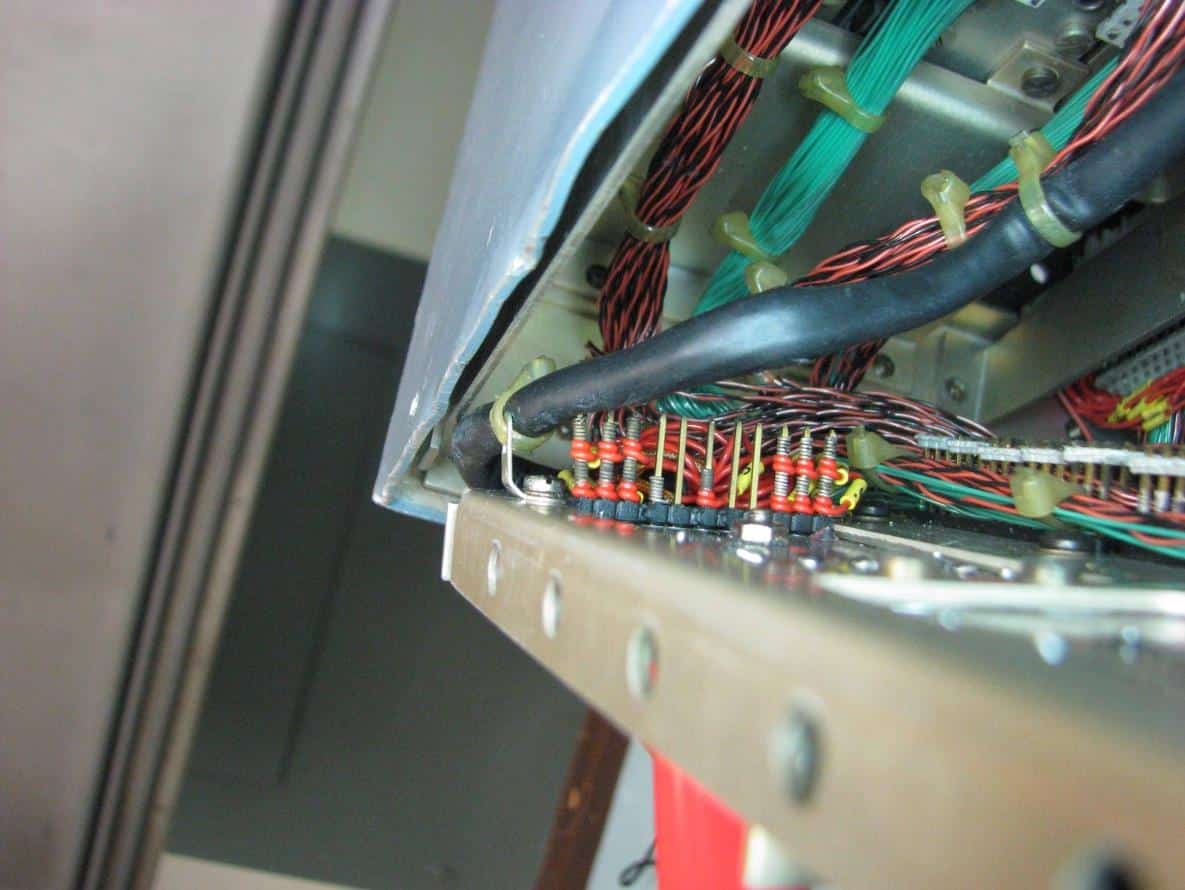
Wire wrap pin penetrating a wire bundle sheath – ELAC S/N 2070
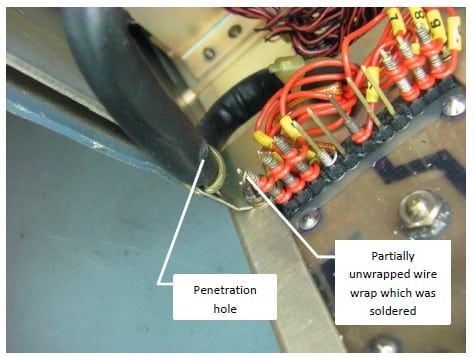
Wire wrap pin penetrated a wire bundle sheath – ELAC S/N 2070

New wire tie down to route cable bundle around wire wrap pin – ELAC S/N 2070
Summary
| ELAC Chassis S/N | Type and Total of Faulty Circuits Found with IFDIS Testing | Testing Results / Comments |
| 6214 | Intermittent faults – 5 total | Two intermittent faults were detected during cold soak; three were detected during heat soak. All faults were repaired by soldering. The ELAC chassis passed all tests during the post repair IFDIS testing. |
| 5983 | Open circuit which was also intermittent – 1; Intermittent fault – 1 | One open circuit was detected during circuit continuity testing. This circuit subsequently also tested intermittent. One intermittent circuit was detected during heat soak. Both faults were repaired by soldering. The ELAC chassis passed all tests during the post repair IFDIS testing. |
| 6331 | Intermittent faults – 3 total | Two intermittent faults were detected during cold soak; one was detected during heat soak. All faults were repaired by soldering. The ELAC chassis passed all tests during the post repair IFDIS testing. |
| 6553 | No faults in newly installed electronics assembly | The original ELAC 6553 had numerous, inconsistent, intermittent faults caused by improper seating due to a broken connector. The most efficient and effective fix was to swap the electronics assembly with one provided by Customer Information Removed. After the new electronics assembly was installed, the ELAC chassis passed all IFDIS testing. |
| 2070 | Shorted circuit – 1; Intermittent faults – 3; partially unwrapped wire wrap – 1 | One shorted circuit was detected during IFDIS short circuit testing. Three intermittent circuits were detected during heat soak testing. The shorted circuit was corrected by repairing and by repositioning the wire bundle that had been penetrated by a wire wrap pin. A new wire bundle tie down was installed to reroute the wire bundle around the wire wrap pins. The intermittent faults and the penetrating wire wrap pin were repaired by soldering. The ELAC passed all tests during the post repair IFDIS testing. |
As a result of IFDIS testing, 13 intermittent circuits were detected in the five ELAC chassis that were provided for this TDP. Of these, four intermittent circuits were discovered during cold soak intermittent testing and eight were found during heat soak intermittent testing. There was one partially unwrapped wire from a wire wrap pin (the shorted pin). A short circuit and an open circuit (which also proved to be intermittent) were also detected in the chassis.
This IFDIS Technology Demonstration Project has clearly verified there were intermittent faults in the ELACs utilized for this TDP that were not being detected by conventional testers currently available to Customer Information Removed. Detecting, isolating and repairing these intermittent faults, which have accumulated over time, should significantly improve ELAC availability. Improvement that will significantly reduce the need the cycle the ELACs through the repair facility, reducing maintenance costs and will also reduce NFF experience of the operator; both of which are unnecessary activities that cost time and money. This step-improvement will also result in a marked reduction in unscheduled downtime.
If not already being done, it is highly recommend that the performance of all ELACs be tracked by serial number. This will enable clear identification of the “poor performing” serial numbered ELACs that would benefit enormously from under-going IFDIS testing. It will also enable calculation of the Mean Time Between Failure before and after IFDIS testing for each ELAC. Additionally, serial number tracking enables calculation of IFDIS testing Return on Investment (ROI). Of course the most important benefit of IFDIS testing is the improved flight safety realized from more reliable avionics boxes.
Disclaimer: The Intermittent Fault Detection & Isolation System (IFDIS) is an engineering diagnostic tool specifically designed to detect and isolate intermittent faults in electronic equipment. The IFDIS does not in any way certify ready for installation or flight worthiness of any component IFDIS tested. Repair, assembly and functional test of any component which has been tested on IFDIS, or any derivatives of this technology shall be undertaken by an FAA approved maintenance authority to the components Design Authority standards before said component can be certified for flight.
This report has been prepared, configured, controlled, issued and stored in accordance with Universal Synaptics Corporation configuration control processes. This report, together with any associated information issued by Universal Synaptics Corporation remains the property Universal Synaptics Corporation.
© 2013. Universal Synaptics Corporation. All Rights Reserved.
This report is copyright and issued on the strict understanding that it is not to be reproduced, copied, or disclosed to a third party, in whole or in part, without the consent of Universal Synaptics Corporation.
